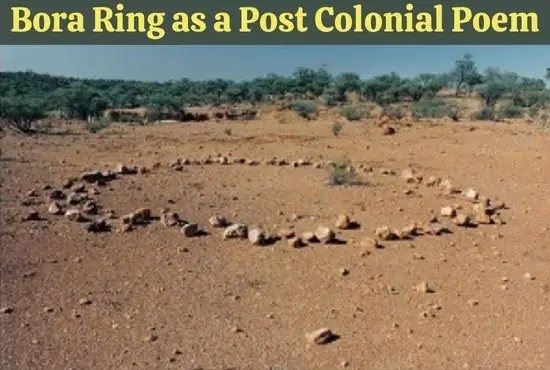Bora Ring as a Post Colonial Poem
“Bora Ring” is a poem written by Australian poet Judith Wright in 1946. It is often interpreted as a postcolonial poem, exploring the relationship between the Indigenous Australian peoples and the colonizers who arrived in Australia in the 18th and 19th centuries.
The poem is set in a bora ring, which is a sacred site for Indigenous Australians where initiation ceremonies were performed. Wright describes the bora ring as a place where the spirits of the ancestors and the land come together. She uses vivid imagery to convey the beauty and power of the site, as well as the connection of Indigenous Australians to their land and culture.
However, the poem also explores the impact of colonization on Indigenous Australians. The speaker of the poem describes how the colonizers “ploughed and planted” the land, destroying the bora ring and the culture it represented. The poem suggests that the colonizers failed to understand the significance of the bora ring and the connection of Indigenous Australians to their land, instead seeing it as empty and ripe for exploitation.
Also Read:
In the first stanza of the poem, Wright describes the bora ring as a “circle of stone” that has been “fenced with sleep.” The use of the word “sleep” creates a sense of stillness and silence, which is then contrasted with the “curlew’s cry” in the second stanza. This contrast suggests that the bora ring is a place of spiritual significance, a place where the natural world and the human world intersect.
However, the third stanza reveals that the bora ring has been abandoned, and that the “flint faces” of the ancestors who once gathered there have been “broken or ground to dust.” This image of destruction highlights the devastating impact of colonialism on Aboriginal culture. The Europeans who arrived in Australia brought with them their own beliefs, values, and ways of life, which often clashed with those of the indigenous people. As a result, many Aboriginal cultural practices, including the use of bora rings, were suppressed or destroyed.
Despite this destruction, the final stanza of the poem suggests that the spirit of the bora ring lives on. The use of the word “dream” to describe the “ghostly gatherings” that still take place in the ring suggests that the bora ring is still a place of spiritual significance, even if it no longer serves its original purpose. The use of the phrase “time’s contrition” suggests that there is a recognition that something has been lost, and that there is a desire to make amends.
Thus, The Bora Ring is a powerful postcolonial poem that celebrates the resilience and persistence of Aboriginal culture in the face of colonialism. By portraying the bora ring as a place of spiritual significance that has been damaged but not destroyed, Wright highlights the ongoing presence of Aboriginal culture in Australia. The poem reminds us that the legacy of colonialism is complex and ongoing, and that there is much work to be done to recognize and address the harm that has been done to indigenous people.

Hello, Viewers! Besides being the Founder and Owner of this website, I am a Government Officer. As a hardcore literary lover, I am pursuing my dream by writing notes and articles related to Literature. Drop me a line anytime, whether it’s about any queries or demands or just to share your well-being. I’d love to hear from you. Thanks for stopping by!
